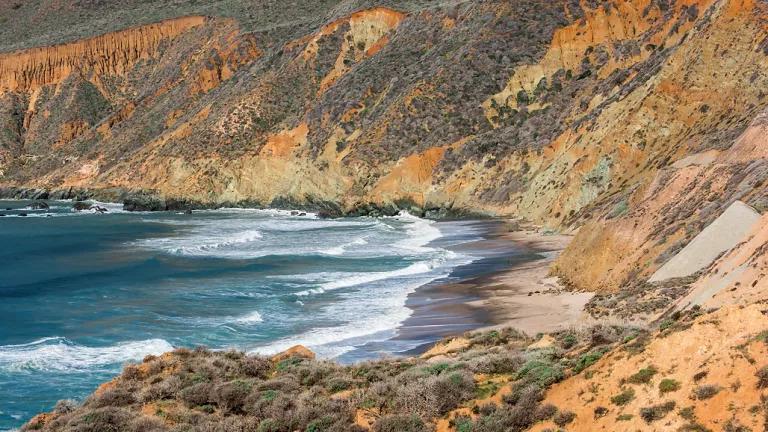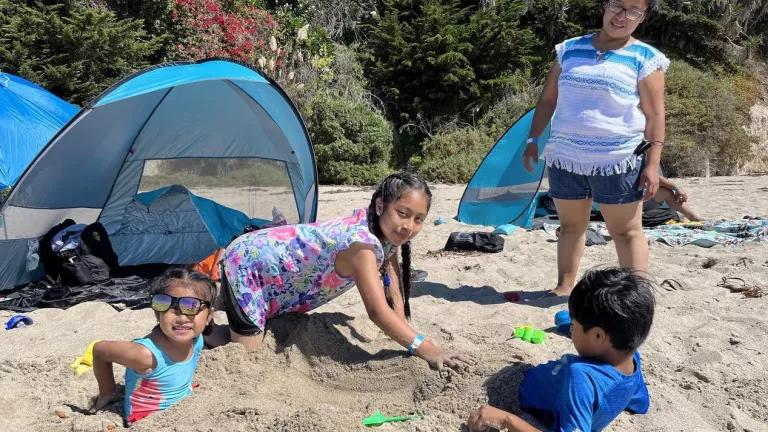Connecting Youth to Nature Supports Equity and Climate Change Goals
Helping youth overcome barriers and connect to blue spaces supports current equity goals and lays the foundation for a bright future in the climate movement

Outdoor Outreach staff member cheering on a surf program participant
Sonia Diaz, Outdoor Outreach
Earlier this year, President Biden declared June 2023 as National Ocean Month. While the newly designated National Ocean Month presents a great opportunity to celebrate our coasts and ocean and strive to protect them for years to come, it is also a good opportunity to reflect on the inequities in coastal access. We’ve written about the sociocultural barriers to access, but in many areas there is also a lack of physical infrastructure that is needed to support equitable access.
Getting to the coast, whether from inland areas or within coastal cities themselves, can be a challenge. Within coastal cities across the United States, decades of redlining and limited public transit options have made many beaches and natural areas practically inaccessible to communities of color. And even for those who might want to or have the means to drive, high gas prices and a lack of affordable parking options at many popular beaches present challenges. Black and Latino Californians are less likely to have access to a car than white Californians, so just reaching the coast can be exceedingly difficult for many of the state’s BIPOC residents.
Physical barriers also include the lack of affordable overnight accommodations, particularly for communities who have to travel long distances to visit a beach. Finding a place to stay in a coastal city can be impossible unless one is willing to spend hundreds of dollars a night. With such a high cost for visits, it's no surprise that wealthier, often white families live near and visit the coast at higher rate than Black and Latino Californians.
When taking all of these factors into account, it makes sense why 62 percent of California voters think that access to the coast is a problem in the state. Fortunately, there are groups working across the state to increase access to coastal areas, such as San Diego based Outdoor Outreach. Operating since 1999, Outdoor Outreach has worked to bring local youth to the coast and cultivate leadership and a sense of belonging among San Diego’s underserved youth. Having served over 17,000 youth since 1999, they have been able to make a large impact across communities, though not without facing significant obstacles.
Due to redlining and inadequate public transit, 75% of Outdoor Outreach program participants lack transportation to get to outdoor spaces, and 44% are not aware of green space near their homes. Being far from the coast is not the only form of physical barrier, however. Sonia Diaz, Public Policy Manager at Outdoor Outreach, noted that “Access is multi-faceted. Even communities in National City and Imperial Beach [neighborhoods with significant Latino populations] that are right on the ocean have some of the most polluted water in the state. It’s not always about proximity or distance. It is by design that the least desirable places in San Diego are where you will find the most people of color.”

Outdoor Outreach surf program instructors on a recent session in San Diego
Sonia Diaz, Outdoor Outreach
Outdoor Outreach steps in to supplement lack of resources and structural barriers to the coast by taking youth on trips to the coast, but their impact doesn’t stop at creating a welcoming space for all. It is a lot of these youths’ first time in these outdoor spaces, so having someone who acts as a “trusted bridge” helps build confidence to return to the coast even if some of the barriers to visiting persist. Youth Programs Coordinator Ramona Wallace noted that this generation is the greenest generation in history and that getting youth outdoors is just the first step. “Once they see that they have a space there, we work with them to develop the tools and resources to make a whole life cycle out of the experience.”
A large part of this life cycle is Outdoor Outreach’s leadership program, which is a paid internship where in addition to trips to natural areas, participants learn leadership and life skills. Many of the instructors in the organization’s other programs are graduates of the leadership program and Diaz works with alumni of the program who have participated in state and local lobbying, gone on to pursue degrees in policy, or found employment with government agencies such as California State Parks and US Fish and Wildlife Service. The leadership program not only functions to help youth overcome barriers to access, but also ensures that the fight for more equitable access continues and has passionate, diverse, and experienced individuals leading the charge.
Despite all the good work Outdoor Outreach is doing, there are still barriers that limit their ability to keep up those efforts, barriers that unfortunately are not limited to San Diego. Diaz and Wallace explained how many cities in the state do not have a permitting process in place for non-profits that work with underrepresented groups and communities. This means that group outings can sometimes be disrupted by park rangers telling them to leave as they do not have the proper permit for their activities. These interactions can be confrontational and unwelcoming and make people less likely to go to the beach as individuals or in groups. After all, it is hard enough to get to the coast for many of these groups, so it is incredibly discouraging when you aren’t welcomed.
To better combat these permitting and physical access issues and share info and best practices, Outdoor Outreach maintains good relationships with other organizations like the YMCA and Brown Girl Surf. Cultivating relationships with coastal communities and environmental agencies to help ease the stress of some of these physical barriers is an important next step for providing a positive experience to coastal visitors. Working with agencies shows youth that there are people like them working in these spaces and makes excursions feel less stressful. Often, wealthier coastal communities are not aware of organizations like Outdoor Outreach, and forging relationships with them can help organizations and individuals experience the coast with less fear of discrimination or prejudice. When coupled with community and governmental cooperation, the grassroots movement Outdoor Outreach is helping to build can address coastal access issues on a larger scale and create an outdoors for all that sustains healthy and vibrant communities.



